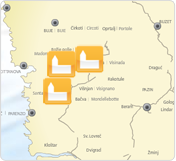
- Gradišće – Koper
- Podpeč – Zanigrad – Hrastovlje
- Slum – Roč – Hum
- Draguć – Paz – Gradinje – Gologorica
- Pićan – Gračišće – Lindar
- Pazin – Beram
- Oprtalj – Čirkoti – Rakotule
- Vižinada – Božje polje – Labinci
- Višnjan – Bačva – Poreč
- Sv. Lovreč – Kloštar
- Šorići – Dvigrad – Kanfanar
- Žminj – Svetvinčenat
- Bale – Batvači – Fažana – Pomer
- Bičići – Barban – Prodol
- Jasenovik – Nova Vas – Vranja
- Plomin – Brseč – Lovran
Vižinada – Božje polje – Labinci
Vižinada
St. Barnabas
Although it may not be the shortest way, however because of its beauty we suggest that you go back to Motovun and pass through the gentle Mirna Valley. The forest along its edge is home of the truffle, delicious and prized underground mushroom and famed Istrian delicacy. Under the Venetian rule the Mirna River was an important waterway for the transport of wood from Ćićarija, which was then used for making oars for Venetian galleys. The engraved inscription below the relief of the Venetian lion on one of the buildings in the square in Vižinada, regulating the wood trade, best speaks of the significance of wood as raw material for Venice. The Baroque-shaped well in the square is the well-known scenography for the festival of chakavian poetry Verši na šterni. In addition to spiritual delights, Vižinada also offers delights for the palate: in mid-August you will surely be seduced by Slatka Istra, festival of Istrian pastries.
The Church of St. Barnabas is situated in the town center. Originally it was a double-apsed church, however in the Baroque the apses were pulled down and the church nave was raised. The frescoes were discovered accidentally when the church was used for storing props while shooting the war film Kelley's Heroes with Clint Eastwood, Telly Savalas and Donald Sutherland. The commonplace iconographic program of the Christological cycle depicts the following scenes: the Nativity, Adoration of the Magi, Massacre of the Innocents, Dispute in the Temple, Last Supper, Crucifixion and Resurrection. In the left part of the western wall the Coronation of the Virgin symbolizes heavenly bliss whereas the suffering in Hell is depicted by hairy devils physically tormenting naked human bodies. Lively, pastel colors have preserved their original brightness, so that this experience presents a true visual delight. Influences of Emilia painting of the Trecento are visible. However, their clear origins are transformed into folk painting of naive expression. Although the bodies are awkwardly executed, the overall impression of paintings is harmonious.
The frescoes are covered with Latin and Glagolitic graffiti and engraved drawings. Not only do they give a lot of information about those who engraved them, but they also comment the frescoes. So, the Glagolitic graffiti in the scene of Hell says: woe betide those who go there!
Seite drucken An Freunde senden
























